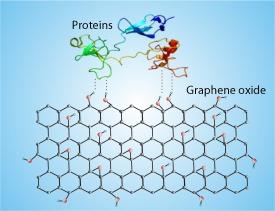

03/26/2012

© 2011 Wiley-VCH
The extraordinary physical properties of graphene — a single layer of carbon atoms arranged in a honeycomb lattice — and its derivatives such as graphene oxide, have excited the interest of scientists and engineers with a view to constructing efficient electronic devices with potentially new functionalities. Graphene-based materials may now also find applications beyond electronics. Haixin Chang, Hongkai Wu and co-workers from the WPI-AIMR at Tohoku University and institutions in Beijing and Hong Kong believe that graphene’s combination of transparency, flexibility and electrical conductivity could enable a wide range of biological and biomedical applications.
At present it remains unclear whether graphene or graphene oxide can be used in vivo, mostly because their toxicity has not yet been established. However, these materials could in theory be used as analysis platforms for proteins and cells in vitro, although the complex interplay between these materials’ surfaces and cells needs to be better understood before any applications can be realistically considered. In their study of cells attached to multi-layer or ‘few-layer’ graphene oxide films, Chang, Wu and colleagues have demonstrated a way to optimize cell performance by controlling the films’ properties1.
The most direct way of changing the surface properties of graphene oxide is by varying its reduction state. The team achieved this by reducing pristine films to various extents using thermal reduction — a method through which oxygen-containing groups are progressively removed when heated. Various aspects of cell behavior were tested using three different substrates: non-reduced graphene oxide films, and films that had been reduced for 90 and 260 minutes respectively.
The researchers first determined the adsorption of various proteins on the films. They observed that the graphene oxide which had been moderately reduced for 90 minutes had the highest adsorption. This can be explained by considering the combination of conflicting effects arising from the high oxygen content. On the one hand, oxygen promotes hydrogen bonding with the proteins, which increases adsorption. On the other hand, it also induces electrostatic forces and hydrophobic changes, which reduces adsorption.
A similar trend was observed in tests to assess cell adhesion, cell proliferation and cell differentiation. In all cases, the best results were obtained for moderately reduced graphene oxide, which the team ascribes to the stronger protein adsorption obtained in those conditions.
These observations could have serious implications for bio-applications. “The present results open up various possibilities to regulate the biological responses in graphene-based materials by controlling their reduction state,” says Chang.
Shi, X., Chang, H., Chen, S., Lai, C., Khademhosseini, A. & Wu, H. Regulating cellular behavior on few-layer reduced graphene oxide films with well-controlled reduction states. Advanced Functional Materials 22, 751–759 (2011). | article
This research highlight has been approved by the authors of the original article and all information and data contained within has been provided by said authors.